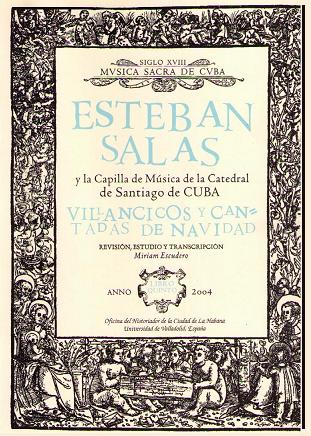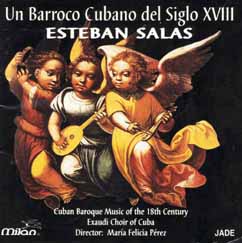* ESTEBAN SALAS, SACRED MUSIC COMPOSER, SANTIAGO DE CUBA CATHEDRAL.
Esteban Salas y Castro (December 25, 1725 – July 14, 1803) was a Cuban composer of religious music. His compositions focused mainly on vocal music and they are a good representation of late Baroque. Although very influenced by French and Italian works of the period, their music is considered to incorporate an original component of Latin America.
It is easy to imagine one of those Christmas end of the 18th century and the first three years of the 19th century in Santiago de Cuba; the city, washed by the waters of the Caribbean Sea, to the Southeast end of the island, unknown today as the icy winter waves; and from Santo Tomás Street between Heredia and San Basilio, way pores Esplanade of cobbles where today is the historic parque Cespedes, was heard the body employing Esteban Salas y Castro inside the Cathedral to play carols and sacred music he composed.
Esteban Salas became Professor and director of music at the chapel of music at the Cathedral of Santiago de Cuba from 1764. He also studied theology and Canon law, and was ordained a priest in Santiago de Cuba in 1790. Salas composed his last carol for Christmas 1801.
Interest in his work was revived during the twentieth century after the rediscovery of many of his scores during the 1940s by the Cuban novelist and musicologist, Alejo Carpentier.
The eclectic architecture of the Centennial property articulated in graceful harmony with the American Baroque, which in music its great Creole exponent was Esteban Salas.
In a period between 1764 and 1803, the musician and composer was the maestro di cappella of the Cathedral of Santiago de Cuba; There formed singers and performers who made sound in Cuba of Europe first from staves.
Born in Havana the same Christmas day of 1725, at the age of eight years joined the choir of the Church parish greater of Havana, displaying his acute child voice as treble. There he learned to play the violin and the organ at the time he received music lessons.
In February 1764 he arrived at Santiago de Cuba, where was appointed, a year earlier, Kapellmeister, by order of the Bishop Pedro Agustín Morell de Santa Cruz.
With the irruption of Esteban Salas in the Santiago church premises, is avenging the veil that unveiled a similar Cuban musical talent. Our music broke through; It is the first composer whose music there is testimony.
Masses, carols, motets, salves and sacramental thicken the Cuban musical heritage contributed by Esteban Salas. Music orchestral, for with or without Orchestra soloists were fruits of the work of an artist who made up relentlessly and with skill.
Much of his work is preserved in the excellent recordings of the Group Ars Longa. Enjoy it is equivalent to traveling with the imagination in those days, when Cuban music made its definitive sprouting.
Sacred seal of Baroque and classical music; music of time he wrote for all time. Delight in the “singing a Duet with violins” or “The passion of our Lord Jesus Christ” is enough to feel pride in having had such Primate musician who ceased to exist on 14 July, in 1803.
We owe it to the writer and researcher Alejo Carpentier encounter with music rooms, a man unknown or forgotten for over a century and a half; that is how it was learned that written on the staff for the habanero in the Santiago de Cuba City, is part of the acquis of the universal culture.
The Conservatory of music in Santiago de Cuba was named in his honor.
Agencies/musicasacra/Alfonso Cadalzo Ruiz/Internet Photos/YouTube/Arnoldo Varona/TheCUbanHistory.com
THE CUBAN HISTORY, HOLLYWOOD.
ESTEBAN SALAS, ORGANISTA DE MÚSICA SACRA, COMPOSITOR.
Esteban Salas y Castro (25 de diciembre de 1725 – 14 de julio de 1803) fue un compositor cubano de música religiosa. Sus composiciones se centró principalmente en la música vocal y son una buena representación de estilo barroco tardío. Aunque muy influenciado por obras francesas e italianas de la época, su música se considera incorporar un componente original de América Latina.
Resulta fácil imaginar una de aquellas Navidades de finales del siglo XVIII y los tres primeros años del siglo XIX en Santiago de Cuba; la ciudad, bañada por las aguas del Mar Caribe, al extremo suroriental de la isla, desconocía como hoy las gélidas olas invernales; y desde la calle Santo Tomás entre San Basilio y Heredia, abriéndose paso pores explanada de adoquines donde hoy está el histórico parque Céspedes, se oía el órgano que Esteban Salas y Castro empleaba dentro de la Catedral para interpretar los villancicos y la música sacra que él mismo compuso.
Esteban Salas se convirtió en profesor y director de música en la capilla de música en la Catedral de Santiago de Cuba desde 1764. También estudió teología y derecho canónico y fue ordenado a sacerdote en Santiago de Cuba en 1790. Salas compuso su último carol de Navidad de 1801.
Interés en sus obras fue restablecido durante el siglo XX tras el redescubrimiento de muchas de sus partituras durante la década de 1940 por el novelista cubano y musicólogo, Alejo Carpentier.
La arquitectura ecléctica del centenario inmueble articulaba en una graciosa armonía con el Barroco Americano del cual en la música fue Esteban Salas su gran exponente criollo.
En un período comprendido entre 1764 y mediados de 1803, aquel músico y compositor fue el maestro de capilla de la Catedral de Santiago de Cuba; allí formó cantores y ejecutantes que hicieron sonar en Cuba los primeros pentagramas provenientes de Europa.
Nacido en La Habana el día mismo de la Navidad de 1725, a la edad de ocho años se unió al Coro de la Iglesia Parroquial Mayor de La Habana, exhibiendo como tiple su aguda voz infantil. Allí aprendió a tocar el violín y el órgano al tiempo que recibió clases de música.
En febrero de 1764 arribó a Santiago de Cuba, donde fue designado, un año antes, maestro de capilla, por disposición del Obispo Pedro Agustín Morell de Santa Cruz.
Con la irrupción de Esteban Salas en los predios eclesiales santiagueros, se descorrió el velo que dio a conocer a semejante talento musical cubano. Nuestra música se abrió paso; es el primer compositor de cuya música existe testimonio.
Misas, villancicos, motetes, salves y autos sacramentales engrosan el patrimonio musical cubano aportado por Esteban Salas. Música orquestal, para solistas con o sin orquesta fueron frutos del quehacer de un artista que componía sin descanso y con destreza.
Gran parte de su obra se conserva en las excelentes grabaciones del grupo Ars Longa. Disfrutarla equivale a viajar con la imaginación por aquellos tiempos, cuando la música cubana hizo su despunte definitivo.
Música sacra con el sello de lo barroco y lo clásico; música de época que escribió para todos los tiempos. Deleitarnos con la “Cantada a dúo con violines” o “La Pasión de Nuestro Señor Jesucristo” basta para sentir el orgullo de haber contado con semejante músico primado quien dejó de existir el 14 de julio, en 1803.
Debemos al escritor e investigador Alejo Carpentier el encuentro con la música de Salas, un hombre desconocido u olvidado durante más de siglo y medio; fue así como se supo que lo escrito en el pentagrama por aquel habanero radicado en la urbe santiaguera, forma parte del acervo de la cultura universal.
El Conservatorio de música de Santiago de Cuba fue nombrado en su honor.
Agencies/musicasacra/Alfonso Cadalzo Ruiz/Internet Photos/YouTube/Arnoldo Varona/TheCUbanHistory.com
THE CUBAN HISTORY, HOLLYWOOD.



 * ESTEBAN SALAS, Sacred Music Composer, Santiago de Cuba Cathedral. (Born: Havana) + ESTEBAN SALAS, Compositor de Música Sacra, Organista Catedral de Santiago de Cuba. (Nacido en La Habana). VIDEO.
* ESTEBAN SALAS, Sacred Music Composer, Santiago de Cuba Cathedral. (Born: Havana) + ESTEBAN SALAS, Compositor de Música Sacra, Organista Catedral de Santiago de Cuba. (Nacido en La Habana). VIDEO.




